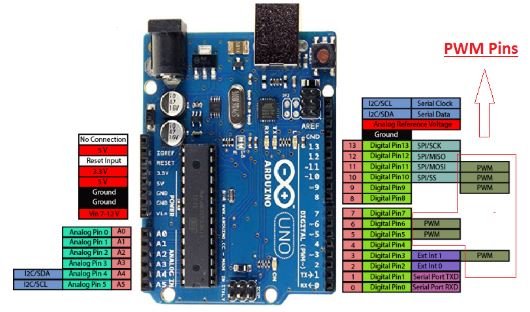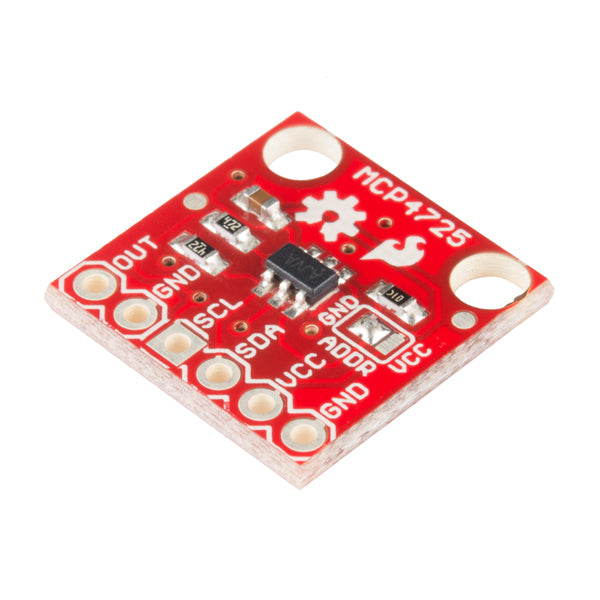
The analog voltage can then be used to control the mosfet.When I first started working with the Arduino platform (it was also my first experience with microcontrollers), I was a little surprised that analogWrite didn’t actually output a voltage, but a PWM (pulse-width modulated) signal. This can be used to easily generate analog voltages. So, if you are at 50 duty cycle and your voltage range is 0-5V you will get 2.5 V. If you use a low pass filter (Resistor to capacitor) you can filter the higher frequency PWM to be an average value of your PWM.
To do so you only need to implement a simple single-pole low pass filter. Fortunately, there is an easy way to convert a PWM signal to an analog voltage. The complementary analogWrite function was there, but no D-A (digital to analog) converter on the AVR chip itself.
Arduino Pwm To Analog Voltage How To Make One
The resolution is 5V / 255 19.61mV per step.Pulse width modulation (or PWM as it is most commonly known), is a way of encoding a voltage onto a fixed frequency carrier wave. This same circuit works with a Microchip PIC as 10-bit with better resolution. The reason we divided the ADC value by 4 is because the PWM as used with Arduino is 8-bit and not 10-bit. PWM PrimerInput Voltage: 7-12V DC recommended, 6-20V DC maximum Digital I/O pins: 14 (6 provide PWM output) Analog Input Pins: 8 (analog input pins also support.The 10K potentiometer connected analog pin 0 is read, divided by 4, then written with analogWrite() to digital pin 11. Once you learn how to make one, you can quickly and easily output analog voltages from not only the Arduino, but PICs as well as any other microcontroller that has PWM output. There are some great online tools to help.
However, it suffers from excessive noise and therefore, FM modulation was invented. It is the most simple modulation scheme to implement, requiring only a single transistor or vacuum tube amplifier as was done in the early days of radio. AM modulation was the first type of modulation used for radio transmissions. Each type of modulation scheme has its own advantages and disadvantages.
One pin outputs the plus (+) and a second pin is the minus ( Arduinos analog pins connect to an analog to digital converter (ADC) that reads the voltage as a 10-bit value from 0 to 1023 (by default), which you can use in your code. Often, PWM is used to create a (time-averaged) variable DC voltage, but here the digital signal duty cycle modulates the SSR AC power cycle. That is why FM radio has superior noise and fidelity qualities over AM radio, though it is not as simple to implement in circuitry.PWM is easily enabled in the Arduino environment and provides accurate eight-bit modulation.
The percentage of the on-time is in proportion to the signal voltage. Instead of varying the modulation frequency with voltage, an output is merely switched on and off at a fixed frequency. The biggest difference is the simplicity and digital nature of the modulation. This technique shares the same noise immunity as FM, to which it is very similar. It adjusts the width of the PWM which is a signal with analog information.With the need for digital communication, a new modulation technique was invented – PWM. In traditional isolated high voltage flyback converters, tight regulation is.
In that case, a value of 255 will also be 5 volts. For our purposes, we will assume the Arduino is running at Vcc = 5 volts. What we want is many cases is a voltage. In the following image, the duty cycle is the output value from the PWM pin of an Arduino divided by 255:For the Arduino, you write a value from 0 to 255 on a PWM pin, and the Arduino library will cause the pin to output a PWM signal whose on time is in proportion to the value written.When it comes time for us to actually write an output voltage, the 0-255 value lacks meaning.
One way to do this would be to read the voltage at an analog pin, and then write it back out. To modulate a signal, we simply call analogWrite with the value corresponding to our signal voltage. Here is the formula:Pin Value (0-255) = 255 * (AnalogVolts / 5) Modulating a SignalIn addition to just setting the output voltage, you may need to actually modulate a signal. We then multiply this percentage by 255 to give us our pin value. That gives us the percentage of our PWM signal. We first divide the voltage we want by the 5 volts maximum.

These values are for a stock Arduino running at 16MHz. For pins 5 and 6, it is about 977 Hz. For pins 3,9,10,11 it is approximately 488 Hz.
If you remember that capacitors block DC currents, but pass AC currents, you can see that any DC voltage input will also be output, but high frequency AC voltages will be shorted to ground. When it is charged, it will cease to conduct current and the voltage at the output of this circuit will match the input (assuming a high impedance load). You will then have a complete D-A converter for your Arduino or other microcontroller.If we examine the circuit on the left, when a voltage is applied to the input of R, the capacitor C will begin to charge. This simple piece of circuitry will convert your PWM output into a voltage corresponding to the percentage of the PWM waveform. Low Pass FilteringNow that you understand how PWM works and can even change the frequency, it is time to take a look at how to implement a simple low pass filter. For example, to change the frequency of timer 2, which controls pins 9 and 10, to 3,906 Hz, you would set its register like so:On the Arduino website, there is a nice tutorial on setting timer frequencies and their ramifications.
Such a filter would incorporate many components in a ladder configuration. While no such ideal filter exists, we can achieve close to it by using a multiple pole filter. In most filters, we would like to have the perfect filter – one that passes all frequencies below the cutoff frequency, with no voltage ripple. Lower frequency AC voltages, they will be filtered according to the R/C time constant formed by the resistor-capacitor network.While this circuit is very simple, choosing the appropriate values for R & C encompass some design decisions – namely, how much ripple can we tolerate and how fast does the filter need to respond? These two parameters are mutually exclusive.
Second, there is a response delay when changing the voltage until the steady-state voltage is reached. First, it limits the speed by which we can vary our output voltage. A low cutoff frequency has two ramifications. We can achieve a reasonable voltage ripple for a single price – a low cutoff frequency.
That happens because our capacitor is too small to filter it out entirely. When we filter this high frequency PWM signal, a small component of it will always make it through the filter. Let’s now look at an example.First, let’s choose our maximum ripple voltage.
A popular application would be to change the voltage of a MOSFET. Therefore, we need to choose a reasonable value for the ripple voltage. That would greatly limit how fast our signal can change and be seen at the output.

Another way to look at this circuit would be to think of it as a poorly regulated power supply. Increase your capacitor until the load has a low enough effect to be acceptable. If you find yourself in such a need, the best approach would be to start with at least a 1uF capacitor and then test how your output voltage changes with load. Designing this circuit for non-trivial loads is beyond the scope of this article. For a recent circuit, I found I needed a 2.2uF capacitor to prevent my modest load from altering the output voltage too significantly. If, on the other hand, we need some current from our output, then we will need a smaller resistor and a correspondingly larger capacitor.
Then drive your load.For our example, let’s choose a capacitor value of 1.0uF. Buffer the output with an op-amp or a FET first.


 0 kommentar(er)
0 kommentar(er)
